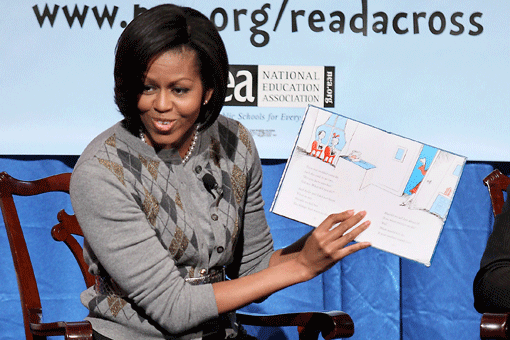National crises can provide windows of opportunity for leaders to advance their agendas. President Barack Obama’s education initiative, known as “Race to the Top” (RTT), is one such example, plunging the federal government even further into the thicket of education reform and policy.
In early 2009, the nation’s economic crisis led to congressional approval of a $787 billion economic stimulus package. Nearly $100 billion was earmarked for education. Although the bulk of those education funds was aimed at plugging hemorrhaging local budgets to prevent teacher layoffs, a smaller subset—around $4.35 billion—was set aside to create RTT.
The RTT program is unique because it is by far the largest competitive grant program that the federal Department of Education has ever administered. Unlike the vast majority of stimulus dollars, states do not automatically receive RTT grants but are required to compete for them by submitting applications to the department.1 And while competitive education grants are not uncommon, most federal education aid is distributed using predetermined formulas.
President Obama’s education secretary, Arne Duncan, has called RTT “the equivalent of education reform’s moon shot.”2 But whether RTT proves to have enduring positive effects will depend on the extent to which it promotes serious reform efforts, whether it reveals insights about how to improve policy across all levels of government, and how well it survives inevitable political challenges.
One such challenge has already been laid down by the National Education Association (NEA), the largest teachers union in the United States, and a traditional ally of the Democratic Party. In a close decision, union delegates voted “no confidence” in RTT at their 2010 annual meeting. The NEA’s vote reflected particular concerns over RTT’s support for using student test score gains in teacher evaluations. Given the NEA’s influence in state and local venues, and the role of its members as key policy implementers, its critical stance will likely affect the efforts of RTT’s advocates to win local supporters that will be needed to adopt and sustain the reforms.
Prior federal education initiatives announced with similar fanfare usually have fallen short of their intended goals. Traditionally, and especially since the 1960s, federal policy has attempted to promote educational equity by improving opportunities for disadvantaged students. In the 1980s, federal policymakers also became increasingly interested in educational excellence, the idea that schools needed to challenge students academically. Achieving both goals simultaneously has been difficult…
Footnotes
1. The ARRA was passed as Public Law 111-5. The RTT fund is described in Title XIV, section 14006 of the law. See http://www.recovery.gov/About/Pages/About.aspx for more details.
2. Arne Duncan, “Education reform’s moon shot,” Washington Post, July 24, 2009. Available at http://www.washingtonpost.com/wp-dyn/content/article/2009/07/23/AR2009072302634_pf.html.
3. Bredsen’s quote is from Erik W. Robelen, “‘Race to Top’ driving policy action across states,” Education Week, December 23, 2009. Hupfeld’s quote is from Alyson Klein, “Colorado pulls out stops in bid for ‘Race to Top’ aid,” Education Week, November 5, 2009.
4. Learning Point Associates, State Legislation: Emerging Trends Reflected in State Phase 1 Race to the Top Applications, June 2010. Available at http://www.learningpt.org/pdfs/RttT_State_Legislation.pdf.
5. Smarick’s quote is from Andy Smarick, “Toothless reform?” Education Next, Spring 2010. Available at http://educationnext.org/toothless-reform/. Williams’s quote is from Erik W. Robelen, “‘Race to Top’ driving policy action across states,” Education Week, December 23, 2009.
6. Berger’s quote is from Associated Press, “States make last-minute reforms to improve Race to Top bids,” Education Week, May 27, 2010. The Wisconsin legislator’s quote is from Andy Smarick, “Toothless reform?” Education Next, Spring 2010. Available at http://educationnext.org/toothless-reform/. Information on the New York budget proposal is from Michele McNeil, “All but 10 states throw hats into Race to Top ring,” Education Week, January 19, 2010.
7. See Associated Press, “States make last-minute reforms to improve Race to Top bids,” Education Week, May 27, 2010 and Associated Press, “Mich. legislature OKs sweeping school reforms,” Education Week, December 21, 2009.
8. Dakarai I. Aarons, “States said to be progressing on data systems,” Education Week, December 2, 2009.
9. The most successful team efforts among states have involved much smaller groups, such as the four states participating in the New England Common Assessment Program. See Pasquale J. DeVito, The Oversight of State Standards and Assessment Programs: Perspectives from a Former State Assessment Director,” Thomas B. Fordham Institute, June 2010, available at: http://edexcellence.net/doc/201006_EducationGovernance_DeVito.pdf.
10. See Paul Manna, Collision Course: Federal Education Policy Meets State and Local Realities (CQ Press, forthcoming in 2010) for an analysis of how U.S. policymakers managed those choices as they implemented the No Child Left Behind Act.





